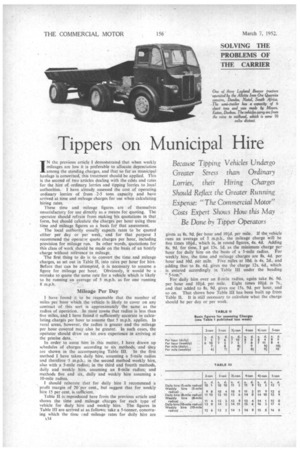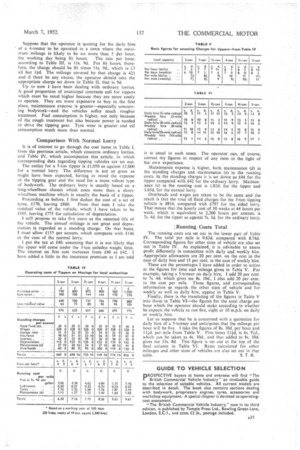Tippers on Municipal Hire
Page 60

Page 63

If you've noticed an error in this article please click here to report it so we can fix it.
IN the previous article I demonstrated that when weekly mileages are low it is preferable to allocate depreciation among the standing charges, and that so far as municipal haulage is concerned, this treantent should be applied. This is the second of two -articles dealing with the cdsts and rates for the hire of ordinary lorries and tipping lorries to local authorities. I have already assessed the cost of operating ordinary lorries of from 2-5 tons capacity and have arrived at time and mileage charges for use when calculating hiring rates.
These time and mileage figures are of themselves unsatisfactory for use directly as_a means for quoting. The operator should refrain from making his quotations in that form, but should calculate the Charges per hour using these time and mileage figures as a. basis fot that assessment. The local authority usually expects rates to be quoted either per day or per week, • and for that purpose I. recommend the operator quote charges per hour, including provision for mileage run. In other words, quotations for this class of work should be made on the basis of an hadrly charge without reference to .mileage.
The first thing to do is to convert. the time, and mileage charges, as set out in Table II, into rates per hour for hire. Before that can be attempted, it is necessary to assume. a figure for mileage per hour. Obviously, it would be a mistake to quote the same rate for a vehicle which is likely to be running an average of 5 m.p.h. as for one running
8 m.p.h. .. .
Mileage Per Day I Wave found it to be reasonable that the number of miles per hour which the vehicle is likely to cover on any contract of this sort is approximately the same as the radius of operation. In most towns that radius is less than five miles, and I have found it sufficiently accurate in calculating charges per hour to assume that 5 m.p.h. applies. In rural areas, however, the radius is greater and the mileage per hour covered inay also be greater. In such cases, the operator should draw on his own experience in arriving at the precise data. .
In order to assist him in this matter, I have drawn up schedules of charges according to six methods, •and they are shown in the accompanying Table III. In the first method I have taken daily hire, assuming a 5-mile radius and therefore .5 m.p.h.; in the second method weekly hire, also with a 5-mile radius; in the third and fourth methods, daily and weekly hire, assuming an 8-mile radius; and .methods five arid six, daily and weekly hire assuming a 10-mile radius.
I should reiterate that for daily hire I recommend a profit margin of 20 per cent., but suggest that for weekly hire 15 per cent, is sufficient.
Table II is reproduced here from the previous article and shows the time and mileage charges for each type of vehicle for daily hire and weekly hire. The figures in Table III are arrived at as follows: take a 5-tonner, concerning which the time r.nd mileage rates for daily hire are A.34
given as 8s. 9d. fcr hour and 101d. per Mile. If the vehicle runs an average of 5 m.p.h., the mileage charge will be five times 100., which is, in round figures, 4s. 4d. Adding 8s. 9d. for time,.I get 13s. Id. as the minimum charge per hour for daily hire on the basis of a 5-mile radius. For weekly hire, the time and mileage charges are 8s. 4d. per hour and 10d. per mile. Five miles at 10d. is 4s. 2d., and adding that to 8s. 4d. gives me the charge 12s. 6d., which is entered accordingly in Table III under the heading "5-ton."
For daily hire over an 8.Inile radius, again 'take 8s. 9d. per hour and 101d. per mile. Eight times 101d. is 7s., and that added to 8s. 9d, gives me 15s. 9d. per hour, and so on. That shows how Table 111 has been built up from Table II. It is still necessary to calculate what the charge should be per day or per week. Suppose that the operator is quoting for the daily hire of a 4-tonrter to be Operated in a town where the maxi-mum mileage is likely to be no more than 5 Or hour,
the working day being 84 hours. The rate per hour, according to Table HI, is I Is. 9d. For 8+ hours, therefore, the charge should be 8+ times Its. 9d., which is 15 all but Lid. The mileage covered by that charge is 424 and if there be any excess, the operator should take the appropriate charge set down in Table II, that is 9d.
Up to now I have been dealing with ordinary lorries. A good proportion of municipal contracts call for tippers which must be rated higher because-they are more costly to operate. They are more expensive to buy in the first place, maintenance expense is greater-especially concerning bodywork-and the vehicles suffer much rougher treatment. Fuel consumption is higher, not only because of the rough treatment but also because power is needed to drive the tipping gear. Tyre wear is greater and oil consumption much more than normal.
Comparison With Normal Lorry It is of interest to go through the cost items in Table I, from the previous article, which concerns ordinary lorries, and Table IV, which accompanies this article, in which corresponding data regarding tipping vehicles are set out.
The outlay for a 5-ton tipper is £1,050 as against £1,000 for a normal lorry. The difference is not as great as might have been expected, having in mind the expense of the tipping gear and the need for a more robust type of bodywork. The ordinary lorry is usually based on a long-wheelbase chassis which costs more than a shortwheelbase machine which is usually the basis of a tipper.
Proceeding as before, I first deduct the cost of a set of tyres, £170, leaving £880". From that sum I take the residual value of the vehicle, which I have taken to be £105, leaving £775 for calculation of depreciation.
I still propose to take five years as the assumed life of the vehicle. The annual mileage is not great and depreciation is regarded as a standing charge. On that basis, must allow £155 per annum, which compares with £146 in the case of the normal lorry.
1 put the tax at £40, assuming that it is not likely that the tipper will come under the 3-ton unladen weight limit. The interest on first cost increases from £40 to £42.. I have added a little to the insurance premium as I am told it is usual in such cases. The operator can, of course, correct my figures in respect of any item in the light of his own experience.
Maintenance expense is higher, both maintenance (d) in the standing charges and maintenance (e) in the running costs. In the standing charges it is set down as £44 for the tipper compared with £42 for the ordinary lorry. Maintenance (e) in the running cost is 1.82d. for the tipper. and I.65d. for the normal lorry.
Overheads and wages are taken to be the same and the result is that the total of fixed charges for the 5-ton tipping vehicle is £816, compared with £797 for the sided lorry. That means that the hourly cost of 50 weeks at 44 hours per week, which is equivalent to 2,200 hours per annum, is 7s. 4d. for the tipper as against 7s, 3d. for the ordinary lorry.
;Running Costs Total The running costs are set out in the lower part of Table IV. The total per mile is 9.63d, compared with 8.74d. Corresponding figures for other sizes of vehicle are also set Out in Table IV. As explained, it is advisable to assess profit differently in connection with daily and weekly hire. Appropriate allowances are 20 per cent, on the cost in the case of daily hire and 15 per cent. in the case of weekly hire.
These are the percentages I have added in order to arrive at the figures for time and mileage given in Table V. For example, taking a 5-tonner on daily hire, I add 20 per cent. to 7s. 4d. which gives me 8s. 10d., I also add 20 per cent. to the cost per mile. These figures, and corresponding information as regards the other sizes of vehicle and for weekly as well as daily hire, appear in Table V.
Finally, there is the translating of the figures in Table V into those in Table VI-the figures for the total charge per hour which the operator should make according to whether he expects the vehicle to run five, eight or 10 m.p.h. on daily or weekly hire.
Let us suppose that he is concerned with a quotation for daily hire of a 5-tormer and anticipates that the mileage per hour will be five. I take the figures of Ss, 10d. per hour and llid, per mile from Table V. Five times lI4d. is 4s, 91d., which can be taken as 4s, 10d., and that added to 8s. 10d. gives Me 13s. 8d. This figure is set out at the top of the final column in Table VI. Rates calculated for other mileages and other sizes of vehicles are also set out in that table. S. T. R.




























































































